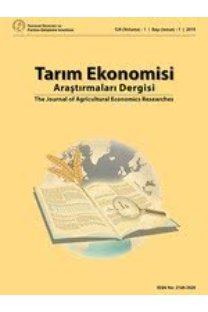Nijerya'da "Hollanda Hastalığı"na Çözüm Olarak Kakao Üretimi
Bu araştırma, FAO veritabanından toplanan 56 yıllık verileri (1961-2017) kullanarak Nijerya'da kakao çekirdeği üretiminin ex-post ve ex-ante performansını belirlemiştir. Toplanan verileri analiz etmek için hem tanımlayıcı hem de çıkarımsal istatistikler kullanılmıştır. Ampirik kanıtlar, üretimin ana itici gücü olan yıllık verimlilik yıllık bazda arttıkça, ülkenin bugüne kadar bağımsız olarak kakao çekirdeği üretimindeki potansiyelini en üst düzeye çıkarmadığını gösterdi. Ayrıca, incelenen dönemlerin çoğu boyunca yıllık alanda çok az değişiklik olmuştur veya hiç değişmemiştir, yani bölgedeki durgunluk, ülkedeki kakao çekirdeği üretiminin üretim trendinin yavaşlamasına katkıda bulunmuştur. Kakao çekirdekleri üretiminin yıllık üretim artışındaki dalgalanma, teknolojik, kurumsal ve pazarlama risklerinden kaynaklanmıştır. Ülke, düşük verimlilik nedeniyle makul miktarda döviz kaybedeceğinden, öngörülen üretim eğilimi cesaret kırıcı. Bu nedenle, çalışma, ülke ekonomisini etkileyen gelir açığını artırmak için daha yüksek bir şansa sahip olduğundan, arzu edilen yüksek verimlilik elde etmek için politika yapıcılar tarafından özellikle iklim akıllı tarım olmak üzere üretim ve geliştirme yatırımlarına acil müdahale çağrısında bulunmaktadır.
Anahtar Kelimeler:
Büyüme, Tahmin, Kararsızlık, Kakao çekirdekleri, Nijerya
Cocoa Production as a Viable Solution to Nigerian “Dutch Disease”
The present research determined the ex-post and ex-ante performance of cocoa beans production in Nigeria using dated data for 56 years (1961-2017) collected from FAO database. Both descriptive and inferential statistics were used to analyze the collected data. The empirical evidence showed that the nation has not maximized its potential in cocoa beans production since independent to date as the annual productivity, which was the major driving force of production increased marginally year-in-year-out. In addition, there was little or no change in the annual area throughout most of the studied periods i.e. stagnation in area contributed to slowing down the production trend of cocoa beans production in the country. The fluctuation in the annual production growth of the cocoa beans production was caused by technological, institutional and marketing risks. The forecasted production trend is disheartening, as the nation will lose a reasonable amount of foreign exchange owing to low productivity. Therefore, the study calls for urgent intervention by the policymakers on production and development investments especially climate-smart agriculture so as to attain desirable high productivity as the crop stands a better chance to shore-up the revenue deficit affecting the nation’s economy.
Keywords:
Cocoa beans, Growth, Forecast, Instability, Nigeria,
___
Ahmed, S.I., Joshi, M.B., 2013. Analysis of Instability and Growth Rate of Cotton in Three District of Marathwada, International Journal of Statistika and Mathematika, 6(3):121-124.Ayalew, B., 2015. Supply Fesponse of Maize in Ethiopia: Cointegeration and Vector Error Correction Approach, Trends in Agricultural Economics, 8 (1):13-20.
Boyal, V.K., Pant, D.C., Mehra, J., 2015. Growth, ınstability and Acreage Response Function in Production of Cumin in Rajasthan, The Bioscan, 10(1):359-362.
CIA, 2011. The World Factbook, Central Intelligence Agency.
Coppock, J.D., 1962. International Economic Instability, McGraw-Hill, New York, pp 523-525.
Cuddy, J.D.A., Valle, P.A.D., 1978. Measuring the Instability of Time Series Data, Oxford Bulletin and Economic Statistics, 40:53-78.
Erelu, O.O., 2008. Cocoa for Health and Wealth, A paper presented in a 4th Cocoa day celebration held on 22nd-24th April, 2008 in Osun State.
GAIN, 2014. Global Agriculture Information Network. Report.
Gujarati, D., Porter, D., Gunasekar, S., 2012. Basic Econometrics, McGraw Hill, New Delhi.
Hazell, P.B.R., 1982. Instability in Indian Food Grain Production, International Food Policy Research Institute. Research Report 30, Washington, D.C., USA.
Kumar, N.S, Joseph, B., Muhammed, J.P.K., 2017. Growth and Instability in Area, Production, and Productivity of Cassava (Manihotesculenta) in Kerala, International Journal of Advance Research, Ideas and Innovations in Technology, 4(1):446-448.
Paul, R.K., 2014. Forecasting Wholesale Price of Pigeon Pea Using Long Memory Time-series Models, Agricultural Economics Research Review, 27(2): 167-176.
Sadiq, M.S., Singh, I.P., Karunakaran, N., 2017. Supply Response of Cereal Crop Farmers to Price and Non-price Factors in Rajasthan State of Nigeria, Journal of Agricultural Economics and Rural Development, 3(2):203-210.
Sandeep, M.V., Thakare, S.S., Ulemale, D.H., 2016. Decomposition Analysis and Acreage Response of Pigeon-pea in Western Vidarbha, Indian Journal of Agricultural Research, 50(5): 461-465.
Sihmla, R., 2014. Growth and Instability in Agricultural Production in Haryana: A District Level Analysis, International Journal of Scientific and Research Publications, 4:1-12.
Stalling, J.L., 1960. Weather Indexes, Journal of Farm Economics, 42: 180-186.
Umar, S.M., Suhasini, K., Jainuddin, S.M., Makama, S.A., 2019. Sources of Growth and Instability in Cassava Production in Nigeria: An Evidence from Hazell’s Decomposition Model, SKUAST Journal of Research, 21(1):86-95.
Umar, S.M., Suhasini, K., Sadiq, M.S., Aminu, A., 2017. Growth and Instability in Yam Production in Nigeria: An Inter Zone and State Level Analysis, Dutse Journal of Agriculture and Food Security, 4(1):10-24.
- Yayın Aralığı: Yılda 2 Sayı
- Başlangıç: 2015
- Yayıncı: Tarımsal Ekonomi ve Politika Geliştirme Enstitüsü Müdürlüğü
Sayıdaki Diğer Makaleler
Türkiye Düzey-2 Bölgelerinde Tarım Alanlarının Yerseçim Katsayısı Metodu ile Değerlendirilmesi
Seçilmiş Tarım Ürünlerinde Karşılaştırmalı Üstünlük: Baltık Ülkeleri Örneği
Nijerya'da "Hollanda Hastalığı"na Çözüm Olarak Kakao Üretimi
Sadiq Mohammed SANUSİ, Invinder Paul SINGH, Muhammad Makarfi AHMAD
Bağımlılık Kuramı ve Türkiye Tarım Politikaları
Nijerya'da "Hollanda Hastalığı"na Çözüm Olarak Kakao Üretimi
Sadiq Mohammed SANUSİ, Invinder Paul SINGH, Muhammad Makarfi AHMAD
